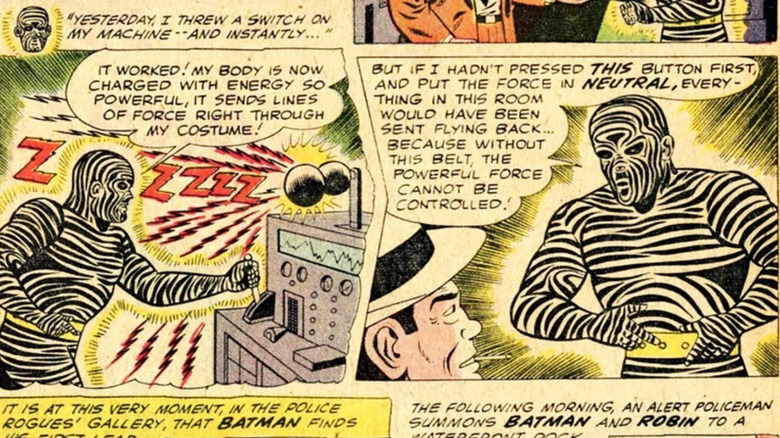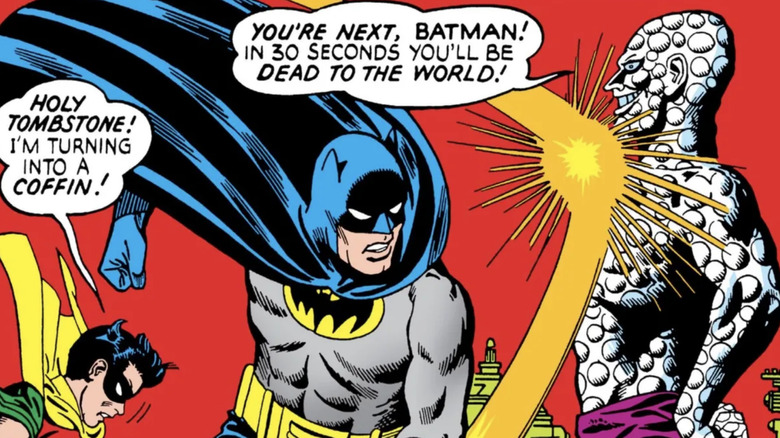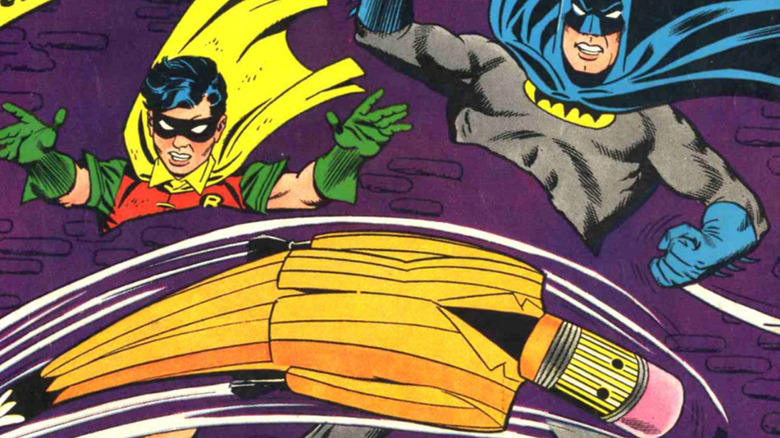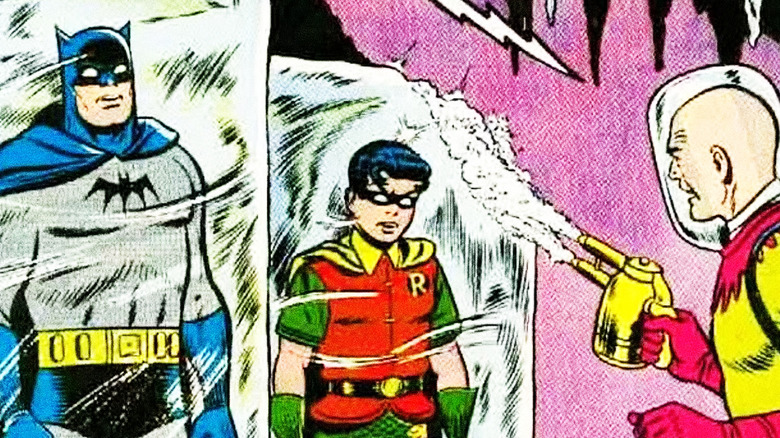5 Most Bizarre Silver Age Batman Villains We'd Love To See In James Gunn's DC Universe
With James Gunn's DC Universe finally starting in earnest with the release of his charming crowd-pleaser "Superman," we're truly in the age of wacky big screen DC heroes. Gunn has a particular penchant for the goofy little guys of comic book history, and thus far we've seen several long-forgotten and overlooked characters unearthed to help bring the burgeoning DC Universe to life. From "Peacemaker" confirming the existence of bizarre DC characters such as Kite Man and Bat-Mite, to the animated "Creature Commandos," which is itself based on more obscure heroes, Gunn's idiosyncratic vision for his cinematic universe is nothing like the languid, desaturated slog that was the former DC Extended Universe.
The big question is how future projects will fit into that vision. Gunn has made clear that, unlike with Marvel Studios, there won't simply be a house style to which filmmakers are beholden, meaning creators are essentially free to do whatever the heck they want (within reason). But how such disparate artistic visions will hang together remains to be seen, especially when it comes to Batman, who is still on track to appear in the upcoming "The Brave and the Bold" movie.
With Matt Reeves busy crafting his own grim and grounded take on the Dark Knight, Gunn will likely want to differentiate the DC Universe version significantly. Luckily, Batman history is packed with plenty of zany villains who would fit quite nicely into such a movie. Most of these abstruse rogues appeared during the character's Silver Age run, where Batman mostly did battle with extraterrestrials and supernaturally-powered criminals. But while such wackiness was par for the course in the 1950s and '60s, some of these villainous creations were just downright bizarre, which makes them perfect for Gunn's cinematic project. Here are a few we want to see.
Zebra-Man
We already know that no characters are off the table for James Gunn's DC Universe and that clashing tones are part of the DC Studios co-head's plan. That means we could see Robert Pattinson's favorite Batman villain, Condiment King, finally show up in a movie. This particularly ridiculous creation doesn't actually come from the Silver Age comics. Rather, he was introduced as an homage to those gimmicky villains in the early '90s by "Batman: The Animated Series" creators Bruce Timm and Paul Dini, who surely had a villain like Zebra-Man in mind when they came up with Condiment King.
Aside from living up to the Silver Age requirement to have an absurd outfit, Zebra-Man was one of the most needlessly confusing rogues to ever show up in a Batman comic. Debuting in 1960's "Detective Comics" #275, Zebra-Man — real name Jacob Baker — was not blessed with the strength or speed of an equine, but rather the power of "diamagnetism." Baker was a scientist who irradiated himself with a machine that turned him into what is essentially the anti-Magneto; he could attract and manipulate anything that wasn't metal. Those black and white stripes represented what the character refers to as "lines of force," like the field of a magnet. After charging himself with energy via his machine, Baker became covered in these lines of force, thus earning himself the Zebra-Man moniker. See, it all makes perfect sense!
Batman co-creator Bill Finger and artist Sheldon Moldoff were responsible for this villain, who has since popped up sporadically in other Batman stories. Now the time is right for Zebra-Man to ascend to the big screen, where Gunn could surely mine the absurdity of this character's origin and his unnecessarily misleading name for humor.
The Outsider
Remember when Alfred turned into a rock man with telekinetic powers? You probably don't, because that particularly unhinged storyline played out all the way back in "Detective Comics" #356 from October 1966. In fact, it started with "Detective Comics" #328, in which Alfred is killed when he pushes Batman and Robin out of the path of a falling boulder and is crushed.
Soon after, the dynamic duo start to receive messages from a mysterious criminal who's eventually revealed to be The Outsider, a white figure with a stone-like body who wears only a pair of purple shorts and is obsessed with vengeance. But this strange new villain is hiding a secret: He's actually Alfred brought back from the dead by physician Brandon Crawford, who used an experimental radiation technique on the poor butler, resulting in his bizarre new appearance.
How did Batman overcome this particular villain? With money, of course. Bruce Wayne discovered The Outsider's true identity and funded his cure, wiping Alfred's memory in the process. Things just sort of returned to normal after that, though The Outsider did make some appearances in future stories, including the 2011 "Flashpoint" storyline, on which the 2022 box office disaster of super-heroic proportions "The Flash" was partially based. That misguided DCEU entry did not feature a version of this villain, so he's still fair game for James Gunn's rebooted cinematic universe — though this one might be too wacky even for Gunn.
The Eraser
The nerd-turned-hero trope is popular in comic books, most notably in the story of how bookish Peter Parker transforms into the wall-crawling Spider-Man. But what about the nerd-turned-human-eraser trope? Of course, when I say "trope," in this case I mean the one off-the-wall story in which this exact series of events played out.
December 1966's "Batman" #188 saw Batman and Robin do battle with rubber-headed villain The Eraser, who likely seemed a formidable villain to fans seeing the cover of the issue on which the dynamic duo are literally being physically deleted. The Eraser was actually the alias of Lenny Fiasco, a former classmate of Bruce Wayne's. During his college years, Lenny was known for constantly making mistakes and using an eraser-tipped pencil all the time. He also had a crush on a girl who Bruce ended up taking to a school event. Naturally, when the poor guy finished college, he turned himself into a human eraser.
This villain's gimmick wasn't just an insane getup. He was employed by Gotham's criminal element to remove all evidence of crimes using his eraser-topped helmet. The unusual antagonist also wore shoes equipped with pencil-point blades that were capable of releasing sleeping gas for some reason. Unfortunately, his illicit business was quickly curtailed by Batman, who posed as an organ grinder and hired The Eraser to clean up a fake robbery. However, the villain recognized Bruce and captured him, before Robin arrived to save the day.
I'm not sure how anybody, including James Gunn, might incorporate a villain as patently silly as this one into a movie, but doing so would be an impressive feat. Maybe the basic idea of a highly-skilled crime scene cleanup crook might make a good addition to Matt Reeves' Batman saga.
Gaggy
The Joker is a singular villain who's long-since transcended his comic book origins to become a pop culture icon in his own right (despite the box office flop that was "Joker: Folie a Deux" threatening to take him down a few pegs). As such, he never really needed any kind of sidekick or criminal cohort to make an impact, though he has been known to welcome allies from time to time. Harley Quinn is, of course, the most obvious example, but what about Gaggy?
Who? Yeah, Gaggy, the little person who became Joker's right-hand man in "Batman" #186 from November 1966. The cover of the issue teases a big return for the Clown Prince of Crime alongside a "hilarious henchman." That little lackey was Gaggy, or Gagsworth A. Gagsworthy to use his full name — a clown who became Joker's sidekick and helped him carry out several heists of valuable artifacts. The character had a high-pitched screech that he used to fend off Batman and Robin and help Joker commit his ambitious thefts, which came to an end when the dynamic duo finally managed to catch Gaggy and his criminal friends during an attempt to steal the original Gotham City Hall. But that wasn't the end for Gaggy, who has since shown up in multiple comic book storylines and even an episode of "Batman: The Brave and the Bold" (which also featured an episode that was banned for being too raunchy).
Bringing this particular character into the DCU would be tough to do in any sort of tasteful way, but if James Gunn is all about giving overlooked and undervalued comic book characters their due, surely there's some way to give the Joker's original sidekick some shine? Hey, it couldn't be worse than "Joker 2."
Mr. Zero
It's strange to think that one of Batman's most famous rogues started as a Silver Age gimmick villain. But that's the genesis of Mr. Freeze, who has experienced several highs and lows in his almost 70-year existence. Arnold Schwarzenegger might have no regrets about his notoriously bad depiction of the villain in "Batman & Robin," but his Mr. Freeze was an undeniable low point for the character, who that same decade received much better treatment in one of the best episodes of "Batman: The Animated Series." Before any of that could play out, however, the character debuted in 1959's "Batman" #121, which featured "the ice crimes of Mr. Zero."
Mr. Zero? Yes, that was Freeze's original name when he first appeared and tried to turn the dynamic duo into "the most valuable live trophies in the world" by encasing them in blocks of ice. It wasn't until the 1960s "Batman" TV series changed the supervillain's name that his more well-known moniker became the standard, and it wasn't until "Batman: TAS" gave him a full backstory that he took on a more tragic tone. When he first appeared in 1959, he was just a mad scientist with an ice gun and a penchant for stealing diamonds, or "ice," from various Gotham establishments. After Batman and Robin tried to apprehend him, the frigid foe froze them in giant blocks of ice. (Batman managed to rock himself enough to smash the ice and escape.)
Since "Batman: TAS" gave us what many regard as the quintessential Mr. Freeze origin, if we're going to have a live-action version of the character, why not try to do what Schwarzenegger couldn't and give us a more lighthearted take? Returning him to his Mr. Zero roots would be an interesting way to do just that.





